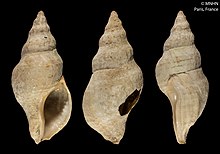Afrocominella capensis, common name the elongate whelk, is a species of sea snail, a marine gastropod mollusc unassigned in the superfamily Buccinoidea.[1]
| Afrocominella capensis | |
|---|---|

| |
| Afrocominella capensis shells (syntype at MNHN, Paris) | |
| Scientific classification | |
| Domain: | Eukaryota |
| Kingdom: | Animalia |
| Phylum: | Mollusca |
| Class: | Gastropoda |
| Subclass: | Caenogastropoda |
| Order: | Neogastropoda |
| Family: | incertae sedis |
| Genus: | Afrocominella |
| Species: | A. capensis
|
| Binomial name | |
| Afrocominella capensis (Dunker in Philippi, 1844)
| |
| Synonyms[1] | |
| |
- Subspecies
- Afrocominella capensis capensis (Dunker in Philippi, 1844) (synonyms: Euthria lacertina Gould, 1860; Fusus capensis Dunker in Philippi, 1844 (basionym) )
- Afrocominella capensis simoniana (Petit de la Saussaye, 1852) (synonyms: Afrocominella elongata (Dunker, 1857); Afrocominella multistriata (Turton, 1932); Cominella alfredensis Bartsch, 1915; Cominella elongata (Dunker, 1857); Euthria multistriata Turton, 1932; Euthria simoniana Petit, 1852; Fusus simonianus Petit de la Saussaye, 1852 (basionym); Glypteuthria solidissima Tomlin, 1932)
Description
editthe length is up to 40 mm, but shallow-water form is longer. [2]
(Description of Afrocominella capensis capensis ) The shell is spindle-shaped to biconic, with proportions that vary. Deep-water specimens tend to be less elongate. The whorls are shouldered, featuring distinct spiral cords and low axial ribs near the shoulder, giving it a somewhat nodular appearance. In mature specimens, the outer lip is thickened and internally ridged, while the siphonal canal is short. [2]
(Description of Afrocominella capensis simoniana) The shell is fusiform and flesh-colored, with varying mottles and dashes of brown. The whorls of the protoconch are decollated, while the post-nuclear whorls feature a sloping shoulder that extends across the posterior three-fifths of the whorls between the sutures. These are marked by weak axial ribs, most prominent at the anterior edge of the shoulder. Thirteen ribs are present on the body whorl, and fourteen on the preceding one.
The spiral sculpture comprises 10 irregular, low, broad cords. The three cords on the shoulder are nearly obsolete and barely visible, while the four on the base are fairly prominent. Additionally, the entire surface is adorned with fine, more or less regular punctate spiral striations. The posterior angle of the aperture is acute, and the outer lip bears nine slender denticles just inside the margin. The columella is glazed with a moderately strong callus, and the parietal lamellae are only slightly developed. Anteriorly, the axial ribs become significantly weaker. [3]
Distribution
editThis species is endemic to South Africa and is found off the Algulhas Bank, subtidal to 160 m. [2]
References
edit- ^ a b Afrocominella capensis. Retrieved through: World Register of Marine Species on 14 July 2012.
- ^ a b c Herbert, D.G., Jones, G.J. & Atkinson, L.J. (2018). Phylum Mollusca. In: Atkinson, L.J. and Sink, K.J. (eds) Field Guide to the Offshore Marine Invertebrates of South Africa. Pretoria: Malachite Marketing and Media. p. 289. doi:10.15493/SAEON.PUB.10000001. ISBN 978-1-86868-098-6. Retrieved 17 October 2024.
{{cite book}}: CS1 maint: multiple names: authors list (link) This article incorporates text from this source, which is available under the CC BY-SA 4.0 license. - ^ Bartsch, P. (1915). "Report on the Turton Collection of South African marine mollusks, with additional notes on other South African shells contained in the United States National Museum". Bulletin. United States National Museum. 91 (12): 46. This article incorporates text from this source, which is in the public domain.
- Steyn, D.G. & Lussi, M. (1998) Marine Shells of South Africa. An Illustrated Collector's Guide to Beached Shells. Ekogilde Publishers, Hartebeespoort, South Africa, ii + 264 pp. page(s): 108
- Kilburn R.N., Marais J.P. & Fraussen K. (2010) Buccinidae. pp. 16–52, in: Marais A.P. & Seccombe A.D. (eds), Identification guide to the seashells of South Africa. Volume 1. Groenkloof: Centre for Molluscan Studies. 376 pp.